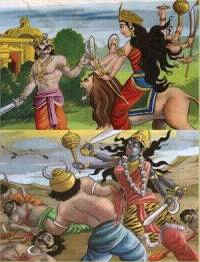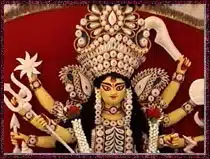
Navratri means- Nav = nine ; Ratri = nights. Nine nights of worshiping Shakti also known as Mother Durga.
Wish You All A Happy Vikram Samvat 2072, celebrated as Gudi Padwa in Maharashtra, Ugadi in Karnataka and Andhra Pradesh. Baisakhi in Punjab, Cheti Chand in Sindh , Naba Barsha in Bengal and Goru Bihu in Assam.
WHEN IS NAVRATRI CELEBRATED?
Navratri is celebrated twice a year once in the month of March/April known as Chaitra Navratri and second in September/ October referred to as Sharad Navratri. Both the navratris 
WHY IS NAVRATRI CELEBRATED?
LEGEND 1 – Killing of Mahishasura – This festival commemorates the victory of Goddess Durga over a demon, Mahishasur. According to Hindu mythology Durga manifested herself to relieve and protect the gods from the demon ‘Mahisasura’ who had driven them out of the heaven and set out to maintain his evil dominion there. As per the legend there once lived a buffalo headed mighty demon named Mahishasura.
He worshiped 
Scared and defeated they pleaded to the Hindu trinity (Brahma, Vishnu, and Shiva), “Lord, we have been thrown out from heaven, from our home. How can it be that heaven is filled with evil- mined demons. How can such a place even be called heaven? Help us get our homes back.”
On hearing their plea the trinity united their powers to help everyone. The face of Lord Vishnu flushed with anger and a brilliant light flooded forth. Soon, the faces of Lord Shiva and Lord Brahma burned with the same dazzling luminescence. The gods watched in wonder as great flames issued forth in all directions.
The fires illuminated all the three worlds: heaven, earth, and the nether-world in the form of a penetrating light. And from this “TEJ” (means illuminating light) Ma Durga or Maa Shakti was born. At a single point, the energy of all these fires combined and became Shakti, in the form of a young woman. Her face was from the light of Shiva. Her ten arms were from Lord Vishnu. Her legs were from Lord Brahma.
All the devtas praised her and contributed their share of energy to form the various limbs of the goddess and armed her with the best of ornaments and deadly weapons – thus Durga represented an awesome combination of supreme beauty and fearsome power.
Lord Krishna gave her a chakara (celestial weapon); Varuna, the sea, gave her a conch; God of fire gave her a missile; Vayu gave her arrows.The king of gods, Indra, gave her a thunder-bolt; from the god of death Durga received a rod.
Durga received many other precious and magical treasures – gifts of jewels, new clothing, and a garland of immortal lotus.God of mountains, Himavat gave her jewels and a magnificent lion to ride into battle.
Now equipped with fearsome weapons from all the gods and dressed in golden armor and jewels she sat gracefully on that lion and sets off on her journey to conqueror Mahishasura. The thunderous roar of the lion shook the three worlds.
Adorned with all the powers Durga entered the battlefield and fought the war with Mahishasura for full nine days.Durga was attacked by many demon commanders, who were all killed immediately, and without mercy. All the demons were destroyed in this great battle as with her divine sword she killed them all.
Mahishasura, king of the demons was shocked and enraged by the disastrous events on the battlefield. He reverted to his own form, a buffalo, and charged towards the battlefield. He ran wildly at Durga’s divine soldiers killing many, biting others and thrashing them with his long, whip-like tail. Durga’s lion, angered by the presence of the demon-buffalo, attacked him. Durga jumped on Mahishasura pushing him to the ground with her left leg.
She grasped his head in one hand, pierced him with her sharp spear held in another, and she beheaded him. Durga fought Mahishasura for full nine days and on the tenth day Mahishasura was killed. At last he fell dead, and the gods returned to their heaven, along with the sages of the earth, they sang praises in the name of Goddess Durga.
Henceforth, and to this day, Goddess Durga is worshiped by all the human beings on earth.
LEGEND 2- Killing of Shumbh- Nishumbh. Shumbh and Nishumbh were two demons who had received boons from Lord Brahma according to which no deity, demon or man could kill them. They became so powerful that their atrocities made the gods leave their seats of power and flee for life.With no solution in sight all the gods got together and prayed to the supreme power to save them.

When Shumbh saw Nishumbh, injured and unconscious, he ran towards Goddess to kill her. Both fought a fierce battle. Finally, Goddess killed Shumbh and Nishumbh by piercing her trident in their heart.
LEGEND 3- Story of Sati. According to another legend of Hindu Mythology, Uma was the daughter of Himalayan King Daksha. She was an ardent devotee of Lord Shiva and wished to marry him and therefore prayed and worshiped him. Finally her prayers were answered and she got married to Lord Shiva, against the wishes of her father. One day Uma heard that her father was organizing a yagya/yagna and she wanted to be a part of that yagya/yagna. She expressed her wish to lord Shiva and he refused to accompany her as he knew King Daksha didn’t like him.
Against his husband’s wish Uma went to her fathers place. Everyone except her father met Uma warmly and inquired about her well being. King Daksha neither greeted her nor asked about her well being rather he insulted Lord Shiva in front of everyone. This infuriated Uma and unable to withstand her husband’s insult Uma ended her life by jumping in the burning fire of that yagya/yagna .
Seeing this everyone was petrified and after this incident Uma was known as SATI. She took another birth as PARVATI and was married to Lord Shiva. It is believed that every year during Navratri’s nine days Sati aslo known as Uma or Parvati visits her parents place and stay there for nine days and these nine days are celebrated as Navratri.
LEGEND4- Story of Shree Ram – Another popular legend behind Navratri is that Lord Shree Ram wanted to free his wife Sita, who was help 
HOW IS NAVRATRI CELEBRATED?
During the nine days period Maa Durga is worshiped with devotion, fasting and strict vegetarian living is adopted. During these nine days devotees of Durga fast and pray for health and prosperity. They also perform the ‘devi-sthaapna’ in their homes wherein they invite the Goddess and perform ‘pooja-path’ for nine days without consuming any food. It is an occasion for vibrant festivities throughout the country. Each day has a religious significance for the devotees.
I
In North – Navratri is a period of fasting and many people observe fasts for full nine days. On the eighth day or Ashtami, devotees break their fasts by calling young girls to their home and these girls are treated as goddess herself. People ceremonially wash their feet, worship them and then offer food to the “girls” giving them the traditional ‘puri’, ‘ halwa’ and chana’ to eat; and gift them with bangles and the red ‘chunnis’ to wear. In spring, during the Chaitra Navratri, the ninth day is known as Ramnavami.
In traditional North Indian households, a pot of wheat, known as ‘khetri’ is kept in homes and worshiped during these nine days. On the first day of Navratras, a pot filled with soil is kept in front of the goddess and grains of wheat or barley are sowed in it. This pot is then watered and worshiped for the next nine days. By the end of the nine days these seedlings 
In various parts of India,’Ram-Leela’ is performed during Navratri. Ram-Leela is a stage enaction of Ramayana,the story of Lord Rama and Mother Sita. In autumn, during Sharad Navratri the last day of Navratri,i.e.,tenth day, is observed as ‘Dassera‘ or ‘Vijayadashmi‘.On this day, Lord Rama had killed the demon Ravana and to mark the victory of good over evil effigies of Ravana are burnt all over India.

NINE FORMS OF DURGA AND THEIR LEGENDS
Nine different manifestations of Durga are worshiped over the nine days period. These nine forms of Maa Durga are –

Source – godhinduwallpaper.com

One day Uma heard that her father was organizing a yagya/yagna and she wanted to be a part of that yagya/yagna. She expressed her wish to lord Shiva and he refused to accompany her as he knew King Daksha didn’t like him. Against his husband’s wish Uma went to her fathers place. Everyone except her father met Uma warmly and inquired about her well being.
King Daksha neither greeted her nor asked about her well being rather he insulted Lord Shiva in front of everyone. This infuriated Uma and unable to withstand her husband’s insult Uma ended her life by jumping in the burning fire of that yagya/yagna .Seeing this everyone was petrified and after this incident Uma was known as SATI or BHAVANI. She took another birth as PARVATI and was married to Lord Shiva.

3. Third Durga Shakti is – Chandraghanta – This form of Durga is very charming, peaceful and luminous. On her forehead she has a half circular moon in the form of a bell and that’s why she is known as Chandra(moon) Ghanta (bell). She has ten hands which carries all kinds of weapons and arrows and she is an image of bravery. She rides a lion and is always positioned to fight the evils.
4. 


Maa Durga was pleased with his devotion and asked for his wish. He asked Goddess to take birth as his daughter. Maa Durga granted him his wish and was born as his daughter and thus she was known as ‘Katyayani”.


Lord Shiva accepted her devotion and when she was cleaned with water from the holy river Ganga, her body turned completely GAUR (white) and thus came to be known as Mahagauri. She wears white clothes and rides a bull carrying a ‘damaru (a small drum) in one hand and ‘trishul’ (a trident) in another. In this form she looks gleaming like a pearl and very peaceful.

Maa Siddhidatri has four arms each holding Gada (mace), Chakra (celestial weapon), Shankh (conch) and lotus flower. Maa Durga in this form is worshiped by all Gods, Rishis-Munis, Yogis, sages and devotees for attaining the best religious asset.
*There are eight Siddhis they are- Anima, Mahima, Garima, Laghima, Prapti, Prakamya, Iisitva & Vasitva.
REFERENCES – http://hinduism.about.com/od/godsgoddesses/ss/navadurga.htm
Books referred – Durga Stuti by Chaman And Navdurga by Geeta press.






Leave a comment